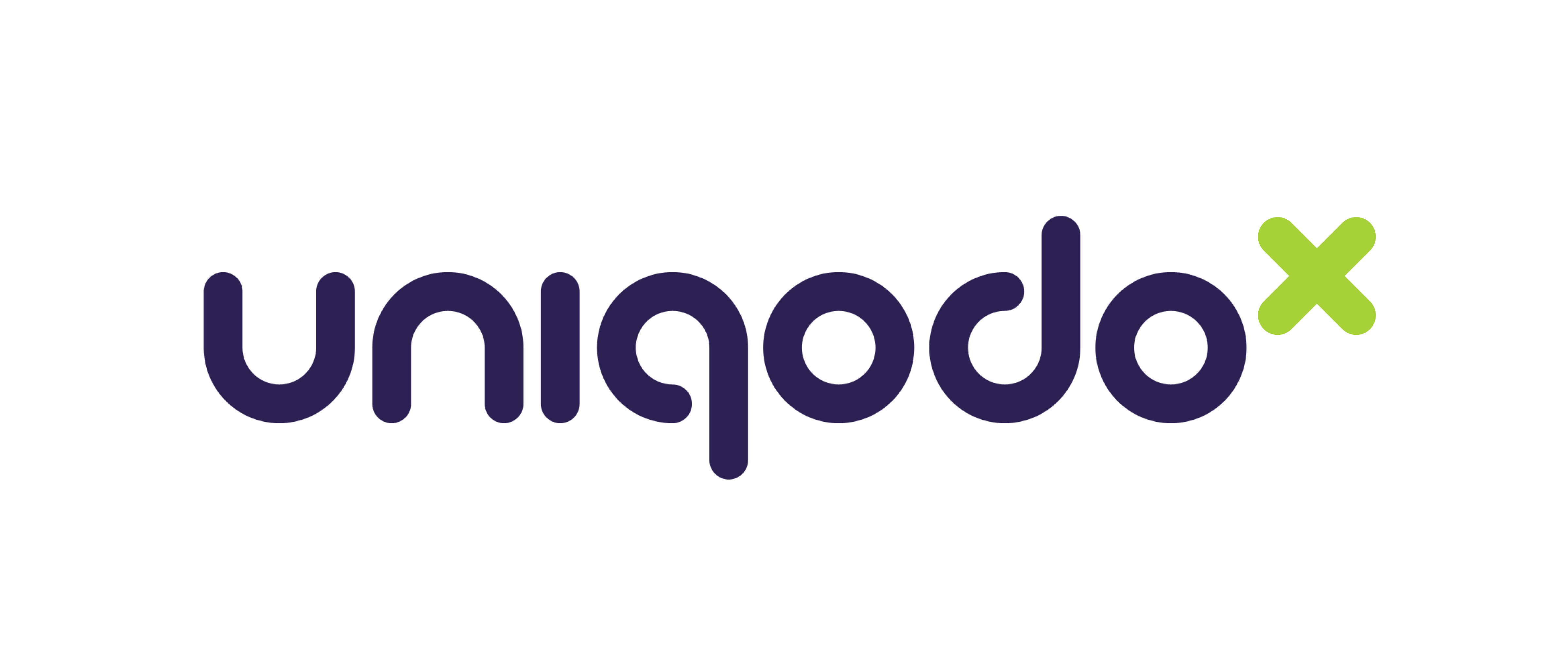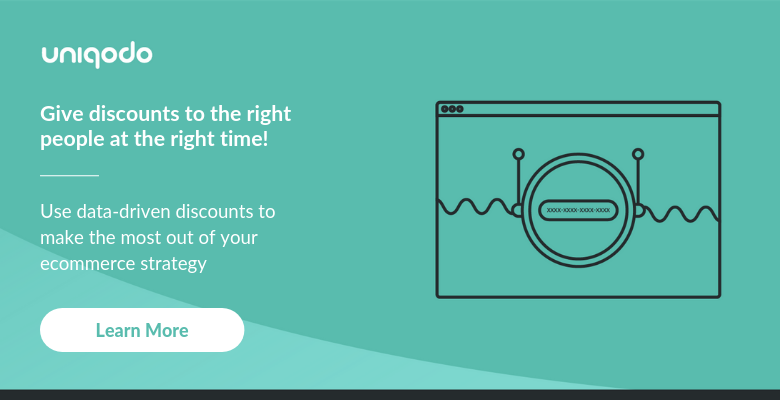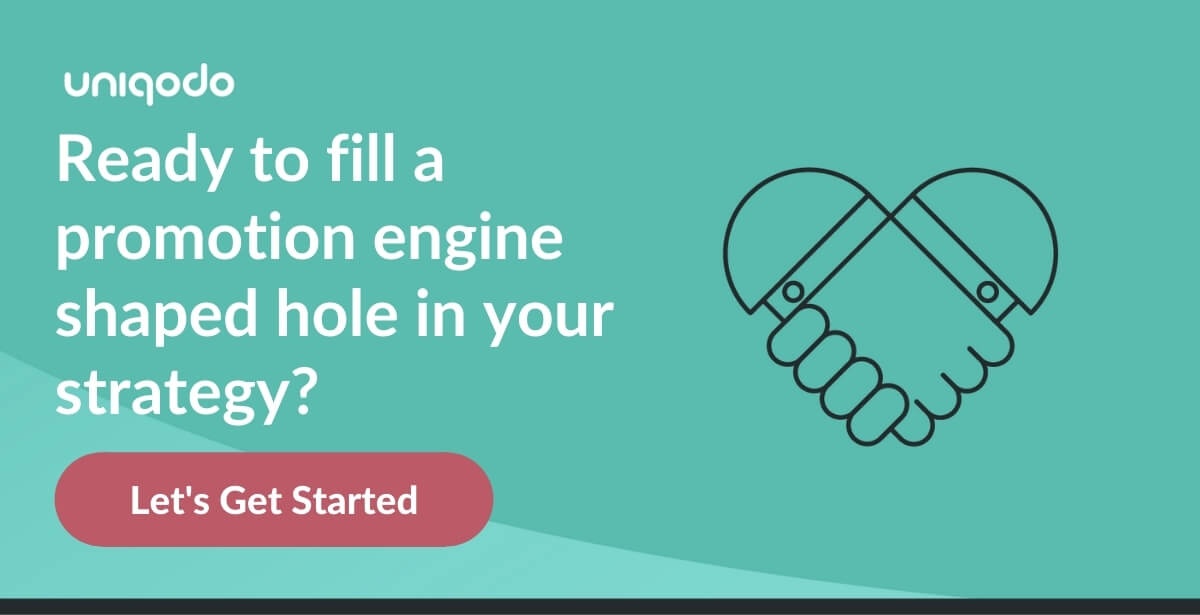Promotion engines need to seamlessly integrate with your other tools and help drive business outcomes not previously possible. When 75% of customers expect promotional offerings, your marketing and sales strategy needs to follow suit. But you can’t damage your bottom line or become buried in admin.
From our own product Uniqodo, to Voucherify and TalonOne, there are a number of quality choices on the market. But they aren’t all the same.
Here, we are going to look at key features of how to promote eCommerce products on engines and what they allow you to accomplish. There isn’t a “right answer” here; it’s about matching your needs and making sure that whatever system you purchase can deliver the outcomes you want.
But first...
What is a promotions engine?
A promotions engine is a piece of software dedicated to the delivery of promotional offerings. First and foremost, a promotions engine automates the generation of reward or discount-based promotions and the validation of repeat-use and single-use, unique voucher codes.
On top of that, a promotions engine should be able to integrate with your CRM, ecommerce platform and/or website, and deliver a number of bespoke, customised capabilities linked to promotional marketing. Let’s get started!
1. Unique/single-use promo codes
Every promotions engine on the market should be able to generate unique, single-use promo codes. Generally speaking, unique codes are synonymous with ‘single-use’. However, you should be able to set unique codes to be used any number of times. The key point is quantity control and unique customisation.
Why this is important:
Unique codes prevent policy abuse. You can distribute promotions knowing that they will only be used for their intended purpose. With the right customer information, you can even assign unique codes to specific individuals. In addition to guaranteeing cost predictions, unique codes open a world of advanced promotional marketing options, including:
-
Time-sensitive discounts: Placing a time limit on promotions creates a sense of urgency and increases redemption rates.
-
Diminishing discounts: You can take time-sensitive discounts one step further and have the discount rate diminish over that set period of time.
-
Personalised and conditional discounts: Unique codes allow you to create specific discounts for specific people. Particularly when it comes to loyalty marketing, this enables you to provide large but limited discounts to specific customers that are personalised to match their past behaviour and incentivise future behaviour. These discounts can be conditional to providing contact details and the exclusivity of these offers adds to the draw.
-
Gamification: Unique promotions can be set to have any number of qualifying features — do X, X number of times, within X time frame”. By turning this into a game, you can improve customer engagement and incentivise different actions.
(Check out our free eBook The Ultimate Guide to Promo Codes if you want more strategic advice).
Fundamentally, unique codes are a prerequisite for a lot of advanced promotional marketing strategies. Although your CRM or ecommerce platform might allow you to generate unique codes (and a tool like Random Code Generator) can provide you with random codes, automating the validation and distribution process is harder. As we will get to later, automating tasks is one of the key features of a quality promotional engine that will let you really engage with all of the options at your disposal.
Pro-tip #1: Although powerful, unique codes aren’t always the right choice for a promotional marketing campaign. Particularly when looking to build brand awareness, generic codes can be more useful. Having a promotion ‘go viral’ is free marketing if it’s done on purpose.
Pro-tip #2: Unique codes are hard to remember — e.g. “AU7CX9962B” as opposed to “Promo4U”. Make sure that you make your codes easy to redeem — automatic form fills, ‘copy code’ buttons, etc. Ensure that you remove friction wherever possible.
2. Integrations and automation
A promotions engine needs to integrate with your existing marketing infrastructure — bringing both automation and simplicity to your operations. Primarily, that means two things:
-
Pulling information directly from your CRM: You want to align promotions to the customer information you have collected — names, birthdays, email addresses, purchase histories, etc. Your promotions engine should be able to pull that information directly when it comes to both generating and validating promotional offerings.
-
Automated distribution parameters: You don’t want to have to create each promo code individually. Your promotions engine should allow you to set up parameters for distribution. For example:
-
Send a promotional email 15% of the time an item is abandoned in a shopping cart, or 25% of the time when an item from a particular product line is abandoned.
-
Send a loyalty promotion every time a customer spends £200 at once, or £500 over time.
-
Send a promotion for a particular item every time one of another three items are purchased.
-
Why this is important:
51% of customers expect personalised offerings. In order to generate personalised and compelling promotions, you need access to customer data. To distribute those codes effectively, you need to be able to set prerequisites rather than having to set each one manually. You want to focus on planning your promotional marketing campaigns, not managing the creation and distribution of promo codes.
Specifics to look out for: Deployment speed
Speed of deployment and integration is an important variable to consider. A lot of promotion engines use an API to integrate with your CRM, and other distribution channels. However, there are other options, including the use of Google Tag Manager, HTML widgets, and JavaScript. A standout feature of Uniqodo is our ability to offer all of these options to get you up and running with the platforms you use as soon as possible.
3. Bridging the gap with third-parties
Promotions are a great tool for partner marketing. They incentivise participation, increase promotional reach, and single-use codes provide a tracking mechanism to attribute success. The right promotions engine can make this easy by allowing for direct integration with those third-party distribution partners.
You want to look for the ability to do three main things:
-
Generate individual codes on demand: A lot of manual processes rely on the issuing of code batches to promotional partners for distribution. This creates challenges if you want to alter the campaign, or your product line changes. If third-parties are able to integrate with your promotions engine directly and generate codes on-demand, you retain far more agility when it comes to planning.
-
-
Control promotional parameters: Although you want promotional partners to be able to directly generate promo codes on their own, you want to know how to retain customers in eCommerce and have full control over promotional parameters. Make sure that the promotions engine is set up to allow permission controlled access by third parties.
-
-
Craft business partnerships: Looking beyond the technical capabilities of the promotions engine, you should investigate the supplier’s relationships within the wider promotional marketing ecosystem. This can help with distribution deals and marketing partnerships.
Why this is important:
Third-party distribution is a valuable asset for customer acquisition campaigns and awareness marketing. If you intend on using promotions for this purpose, having a simple system set-up for communicating with those partners is critical. The more flexible and automated that system is, the more effective and controlled your campaigns can be.
4. Validation, tracking and analytics
Every promotions engine will be able to validate the codes it generates, but the level of sophistication in which this is done impacts your options. Simply checking if a code has already been used is one thing. But validation starts to get more complicated the more criteria you put in place for your promotional campaign.
For example, an airline company might issue a promotional campaign to drive increased passenger loads for low-volume flights. A simple way to do this would be to discount that flight. However, in order to retain eCommerce profit margins, you could offer a different promotion based on taking that flight — only valid once the flight has been completed.
You should look out for the ability to track individual codes and align them with specific individuals and specific actions.
Why this is important:
Tracking capabilities not only open up the possibility of more advanced discounting strategies, they allow you to test your success and provide better customer service.
-
A/B testing: Granular validation allows you to A/B test different messaging, hone in on personalised messaging for specific people, and improve your overall outcomes. The more specific validation criteria a promotions engine provides, the more specific you will be able to get in terms of analysing those results. If you want to engage with both the most advanced promotional marketing strategies and most sophisticated analysis patterns, you need granular reporting and tracking capabilities.
-
Customer service: Customers don’t like being told that their promotion is invalid. A lot of standard promotional campaigns only have the ability to accredit a code as valid or not. However, if you are able to track and analyse each criteria of validation, you can pass that information onto customers. That way, a customer can be told specifically why their code is invalid (if it is invalid), providing them with information on how to qualify.
5. Bespoke development and consulting
The fundamentals of code generation, distribution and validation are all core to the value of a promotions engine. But things get more interesting when they get more customised. Ultimately, with a little tinkering, you can get a lot of the basic automation capabilities of a promo engine out of your CRM — or build a tool in-house. What those options don’t get you is access to specialists able to help you push the boundaries of a promotional marketing strategy.
Ultimately, a promo engine needs to be easily tailored and customised to meet your needs. Third-party providers should have the ability to react quickly and make bespoke improvements to match changing circumstances. Consider the following:
-
Onsite promotions:The ability to connect with customers directly through your website can be the most effective way to deliver promotional messaging. A lot of brands advertise generic sales on their website. But a sophisticated promotions engine will allow you to apply all of the personalised promotional strategies we have discussed here, directly on your website.
For example, JavaScript embedded promotions can issue codes on your webpage to chosen audiences and site visitors. These codes can be issued on-demand through personalised HTML widgets or pop-up displays. You can then set any number of parameters for display — including shopping cart abandonment, total number of webpage visits, total number of products purchased, specific products/services purchased etc.
-
Advanced distribution criteria: Automating when a promotion should be generated is a critical promotions engine capability. However, it’s possible to go beyond simple customer loyalty schemes or shopping cart abandonment targeting to align your promotions with business goals.
For example, a retailer might want to tailor promotions based on product margins, or increase the number of issued promotions if sales volumes for certain product lines slow down. Travel companies will want to design promotional criteria to minimise lost revenue by maximising capacity.
As the number of criteria for issuing a discount increases, the less likely it is that an out-of-the-box solution will be able to fully automate the task. This is particularly true for industry-specific needs. Having a promotions partner able to customise their technology to meet your demands can go a long way into transforming a ‘workable’ solution into a seamless one.
-
Outcome-driven promotions: It’s not always simple deciding the best way to promote a product. In addition to solving technical challenges, some promotions engines double as promotional marketing consultants — providing bespoke advice on the best way to drive specific outcomes using promotions technology.
Why this is important:
The value of bespoke technical and strategic support will depend on the sophistication of the campaign you want to execute. The more outcome-driven your promotional strategy needs to be, the more value you will gain from promo engine providers able to supply customised support.
Smaller companies will benefit from access to dedicated specialist resources, while larger businesses can outsource more agile tasks. Either way, ‘support’ is a critical capability to look for — particularly if offered as an ad-hoc option, rather than a prerequisite to self-service SaaS.
Promotions-as-a-service
Something that makes Uniqodo really stand out is our ability to act as both a SaaS product and strategic partner. Ultimately, we can deliver a fully managed promotional marketing campaign as a service to simply deliver outcomes rather than software. However, our ability to deliver a self-service but customisable product is also core to our mission.
Picking the right promotions engine comes down to analysing which of the outcomes we have described here align with your business needs. As you move further down the list, you move closer and closer to a solution that only aligns with what Uniqodo has to offer. With that said, there are a number of ways to build and engage with a promotional marketing strategy. If you want strategic or technical advice, we’d be happy to get in touch.




Subscribe to the Blog